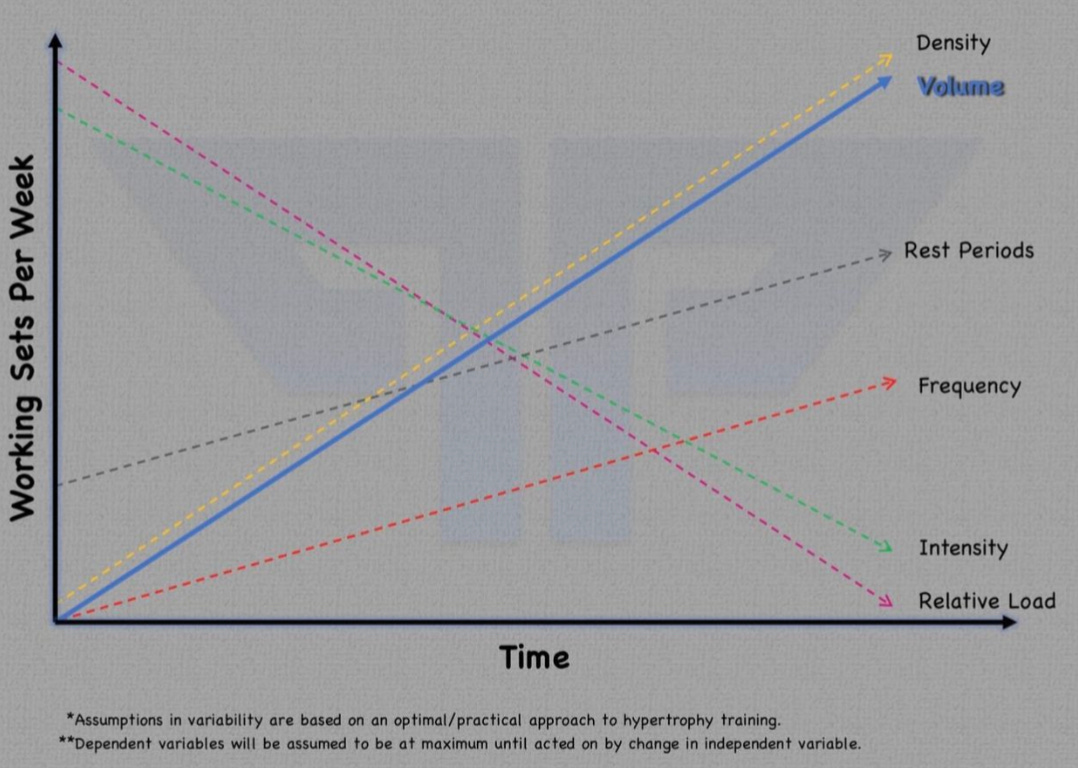A measure of total work done.
First up will be how linear changes in VOLUME over time (both weekly and single sessions) affect our other variables.
We first must assume a baseline of parameters in order to create a realistic scenario in which hypertrophy is the ultimate goal. We will have to continually reestablish our assumptions when highlighting each variable to provide necessary context.
For the sake of this exercise, we have stated that:
- All set volume is performed on a single bodypart/lift versus divided up systemically (i.e. all sets inferred to be from leg extension/biceps curls/etc)
- Density- 1:1 ratio with volume
- Frequency=-2x/wk
- Intensity- 3RIR
- Relative Load- 70% of 1RM
- Rest Periods- 3 min between sets
The effects discussed — and graphed — are going to be a function of an isolated comparison between our independent variable (here, volume) and a dependent variable (we will evaluate them one at a time). The above parameters will act as standardization values when those variables are not being compared directly to volume.
Density
Because density is a function of volume per unit of time, it is mandated that as volume increases so too will density, proportionally. This will remain constant regardless of what scale of time we are using here.
Frequency
- Weekly– We must be able to distribute volume over the week to meet the criteria of set per session minimums and maximums that are effectively stimulatory (research has shown between 5-15 sets to be a sweet spot). As we “fill up” sessions with more volume, we must add more opportunities to accommodate higher recovery demands (i.e. increase frequency).
- Intrasession– This can get tricky because we have to look at how the weekly frequency is affected by the changes in single session volume. As we add volume to a given workout, the number of sessions in which we can replicate that workload must actually go down across the rest of the week. This is due to the greater amount of muscle damage — and recovery deficit — being created in that single session. And this requires more time for recovery between sessions in order to be ready for the next overloading stimulus.
Intensity
When we try to pack tons of volume into a single session or week (i.e. create greater density), our ability to recover begins to become a limiting factor relatively quickly. To offset the fatigue and damage being generated by the increase in volume, our average proximity to failure per set has to decrease to balance the scales — otherwise, stagnation and injury will result. Some trainees may be able to physically perform 20 sets to failure in a single session or 50 over the course of a week, but this is far from practical or sustainable. In fact, a reduction in proximity to failure (to accommodate the increasing volumes) will actually prove to be more hypertrophic.
Relative Load
Similar to intensity, the load on the bar as it relates to our individual strength levels (i.e. % of 1RM) must drop as volume increases, both intrasession and weekly. Beyond the fatigue being generated, it’s just simply inefficient to try to sustain very-high average relative loads rather than shifting some volume towards the higher-end of the hypertrophic range. Decreasing the weight being used in order to alleviate some of the costs of increasing volumes creates a buffer zone of additional effective reps and less risk of injury without falling off the recovery cliff.
Rest Periods
- Weekly– With rising volumes over the week, we will see a vast increase in fatigue generated, as maintaining baseline levels of the other variables — specifically intensity and relative load — becomes more and more taxing. This will force rest periods to increase in order to sustain sufficient performance benchmarks.
- Intrasession– A paradox intrinsic to rest presents itself when looking at the duration of an individual session as volume continues to rise. After early increases in conjunction with volume to preserve effective reps, rest periods must actually be reduced at a certain point to stay within the realm of practicality (we can’t have 4 hour sessions). And this must be approached with the understanding that there will be a harsh hypertrophic tradeoff with more intrasession volume and less rest between those sets.
Volume is the most pliable variable we will cover, which also means that its ability to impact training with large undulations is immense. Moving from low to high volume or vice versa can have downstream effects that may not be immediately present, but understanding how these trends tend to play out over time is crucial for advanced levels of program management and implementation. Though the generalities discussed above (and presented below) are not universal truths, using these concepts as a framework will, more often than not, guide you in the right direction.



